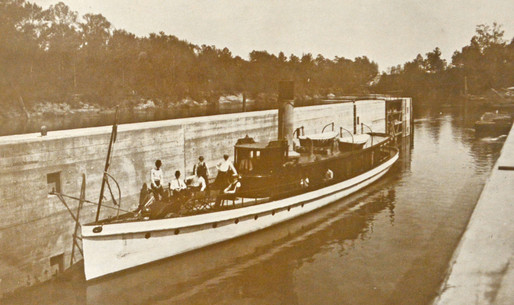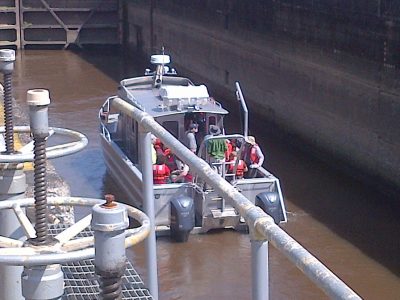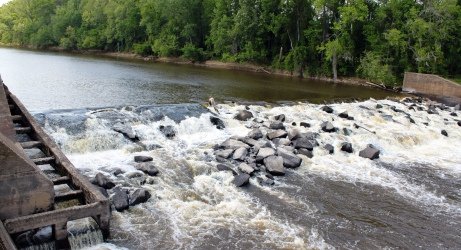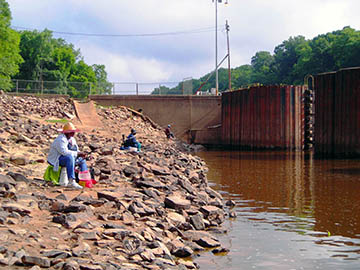
WILMINGTON – The Army Corps of Engineers is looking into the possibility of disposing of or removing the locks and dams in the Cape Fear River.
Corps officials will determine whether the federal agency should take no action, deauthorize Locks and Dams 1, 2 and 3 and hand them over to a nonfederal entity, such as the state or local governments, or demolish the structures.
Supporter Spotlight
The Corps launched a so-called disposition study earlier this year because the locks and dams, built decades ago to maintain a navigable channel for commercial barges traveling from Wilmington to Fayetteville, are no longer needed for the purpose in which they were constructed.
Commercial use ceased in 1995, according to Lisa Parker, chief public affairs officer of the Corps’ Wilmington District.
“Occasional recreational and small-scale sight-seeing lockages have occurred,” Parker wrote in an email responding to questions.
Maintaining the locks and dams, which were built between 1915 and 1935, costs the Corps about $800,000 a year and refurbishing them would be a “considerable investment.”
“One of the alternatives that must be evaluated is the possible removal of all or part of the structures, to render them ‘safe,’ and related impacts from removal,” Parker wrote. “There is no way of knowing the environmental effects of removal options at this time. Effects could include: changes in vegetation and species, changes in groundwater levels and flow direction in the floodplains, changes in water surfaces within the channel, and other effects. Impacts to communities and industry could be substantial, and will also be evaluated.”
Supporter Spotlight

But demolition of the locks and dams is “unlikely given stakeholder interest,” she stated.
Local communities and industries draw water from the pools behind all three dams.
The locks and dams help protect water intakes and they’ve become popular recreation areas complete with boat ramps, restrooms, picnic tables, grills and picnic shelters.
The North Carolina General Assembly noted some of the concerns associated with the removal of the structures from the Cape Fear River when it enacted in 2008 a bill accepting, with conditions, the transfer of the locks and dams.
House Bill 2785 identifies the following concerns:
- The absence of locks and dams No. 2 and No. 3 “jeopardizes existing and/or potential water supply intakes” above those structures.
- Removing Lock and Dams No. 2 and No. 3 “would lower the river surface by upwards of 20 feet and potentially compromise water quality in the middle and lower subbasins” of the river.
Under the bill, the state would accept the transfer of the locks and dams and all federally owned adjacent lands with the stipulation that all three structures be “properly refurbished” and rock arch rapids fish ladders constructed at each one.
The cost estimate to restore locks and dams 2 and 3 is to be identified in the study.
Currently, Lock and Dam No. 1 is the only one of the three structures with a rock arch rapids designed to allow migratory fish such as shad, river herring, striped bass, Atlantic sturgeon and shortnose sturgeon to travel upstream. Lock and Dam No. 1 is at Kings Bluff, about 39 miles above Wilmington on the river.
That project, completed in 2012, was paid for with Federal American Recovery and Reinvestment Act and state funds as a mitigation requirement for the Wilmington Harbor 96 Act navigation deepening project. The project cost $10.9 million.

An additional $3.4 million was spent to fill a scour hole so that the structure could support fish passage, Parker stated.
Less than a month ago, Cape Fear River Watch submitted a Section 408 application to the Corps requesting a proposal to improve passage at Lock and Dam No. 1 by creating wider gaps in the rocks and larger pools for fish such as striped bass and sturgeon, according to Cape Fear River Partnership Coordinator Dawn York.
More than $3 million, $1.6 million of which was funded by the North Carolina Division of Water Resources, has been allocated to the design of fish passages at Locks and Dams 2 and 3, York said.
It is unclear when an application for those proposed projects would be submitted. York said she was unsure whether the Corps could consider an application while the disposition study is underway.
The study is expected to be complete within 12 to 18 months, according to Parker.
“Things could really change depending on who would take over the locks and dams,” York said.
At this point, that’s anyone’s guess.
“I know that some conversations have been initiated,” York said. “So far no one has stepped up and said we’ll take care of it. No one has been held to the fire to say this is it, this is what we’re going to do with them. It can be a little complicated, but there’s a lot of potential. Certainly, we can look to who would have the resources and willingness to take them on. You may have different parties taking on different parts.”

Take Elizabethtown, for example. The Bladen County town leases the federal land at Lock and Dam No. 2, which is 2 miles from the town’s courthouse, for recreation. What if the town were to take over the lockmaster house and use it as an education center?
Or, what if Bladen County or the state permanently closed the locks and maintained the dams?
What if the Fayetteville Public Works Commission, which has been vocal about future water supply for the city and Army base Fort Bragg, took control of Lock and Dam No. 3, which is just 17 miles southeast of the city?
“It’s sort of just a guessing game as to who’s going to step up to the plate,” York said. “What’s the liability if we have another hurricane like Hurricane Matthew? There was a lot of damage and the Corps spent quite a lot of money to get the lock chambers up and running. Obviously, the cleanest would be for one entity to take them all over. We just want to see a good outcome.”
The Corps expects to host a public scoping meeting of the study sometime this month in which representatives of various agencies, municipalities and counties will be given the opportunity to comment on the study in the morning. The Corps will accept comments from the general public during the afternoon.








